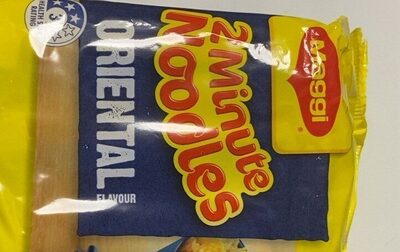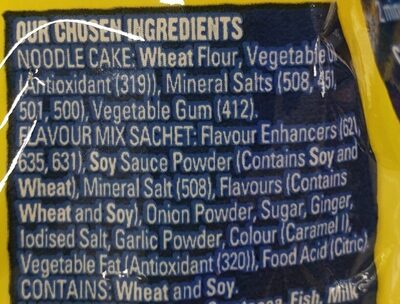Help us make food transparency the norm!
As a non-profit organization, we depend on your donations to continue informing consumers around the world about what they eat.
The food revolution starts with you!
Oriental Maggi Orientation Noodles - 1
Oriental Maggi Orientation Noodles - 1
This product page is not complete. You can help to complete it by editing it and adding more data from the photos we have, or by taking more photos using the app for Android or iPhone/iPad. Thank you!
×
Barcode: 9556001137678 (EAN / EAN-13)
Quantity: 1
Brands: Maggi
Categories: Plant-based foods and beverages, Plant-based foods, Dried products, Pastas, Dried products to be rehydrated, Noodles, Instant noodles
Labels, certifications, awards:
Health Star Rating, Health Star Rating 3, Verified
Stores: Woolworths, Coles
Countries where sold: Australia, New Zealand
Matching with your preferences
Health
Ingredients
-
29 ingredients
noodle cake: wheat flour, vegetable antioxidant (319)), mineral salts (508,451, 501,500), vegetable gum (412), flavour mix sachet: flavour enhancers (62 635, 631), soy sauce powder (contains soy and wheat), mineral salt (508), flavours (contains wheat and soy), onion powder, sugar, ginger, iodised salt, garlic powder, colour (caramel i) vegetable fat (antioxidant (320)), food acid (citric acid) contains: wheat and soy, fish, milkAllergens: Fish, Gluten, Milk, Soybeans
Food processing
-
Ultra processed foods
Elements that indicate the product is in the 4 - Ultra processed food and drink products group:
- Additive: E412 - Guar gum
- Additive: E451 - Triphosphates
- Additive: E631 - Disodium inosinate
- Additive: E635 - Disodium 5'-ribonucleotide
- Ingredient: Colour
- Ingredient: Flavour enhancer
- Ingredient: Flavouring
Food products are classified into 4 groups according to their degree of processing:
- Unprocessed or minimally processed foods
- Processed culinary ingredients
- Processed foods
- Ultra processed foods
The determination of the group is based on the category of the product and on the ingredients it contains.
Additives
-
E319 - Tertiary-butylhydroquinone (tbhq)
Tert-Butylhydroquinone: tert-Butylhydroquinone -TBHQ, tertiary butylhydroquinone- is a synthetic aromatic organic compound which is a type of phenol. It is a derivative of hydroquinone, substituted with a tert-butyl group.Source: Wikipedia
-
E320 - Butylated hydroxyanisole (bha)
Butylated hydroxyanisole: Butylated hydroxyanisole -BHA- is an antioxidant consisting of a mixture of two isomeric organic compounds, 2-tert-butyl-4-hydroxyanisole and 3-tert-butyl-4-hydroxyanisole. It is prepared from 4-methoxyphenol and isobutylene. It is a waxy solid used as a food additive with the E number E320. The primary use for BHA is as an antioxidant and preservative in food, food packaging, animal feed, cosmetics, rubber, and petroleum products. BHA also is commonly used in medicines, such as isotretinoin, lovastatin, and simvastatin, among others.Source: Wikipedia
-
E412 - Guar gum
Guar gum (E412) is a natural food additive derived from guar beans.
This white, odorless powder is valued for its remarkable thickening and stabilizing properties, making it a common ingredient in various food products, including sauces, dressings, and ice creams.
When used in moderation, guar gum is considered safe for consumption, with no known adverse health effects.
-
E451 - Triphosphates
Sodium triphosphate: Sodium triphosphate -STP-, also sodium tripolyphosphate -STPP-, or tripolyphosphate -TPP-,- is an inorganic compound with formula Na5P3O10. It is the sodium salt of the polyphosphate penta-anion, which is the conjugate base of triphosphoric acid. It is produced on a large scale as a component of many domestic and industrial products, especially detergents. Environmental problems associated with eutrophication are attributed to its widespread use.Source: Wikipedia
-
E500 - Sodium carbonates
Sodium carbonates (E500) are compounds commonly used in food preparation as leavening agents, helping baked goods rise by releasing carbon dioxide when they interact with acids.
Often found in baking soda, they regulate the pH of food, preventing it from becoming too acidic or too alkaline. In the culinary world, sodium carbonates can also enhance the texture and structure of foods, such as noodles, by modifying the gluten network.
Generally recognized as safe, sodium carbonates are non-toxic when consumed in typical amounts found in food.
-
E501 - Potassium carbonates
Potassium carbonate: Potassium carbonate -K2CO3- is a white salt, which is soluble in water -insoluble in ethanol- and forms a strongly alkaline solution. It can be made as the product of potassium hydroxide's absorbent reaction with carbon dioxide. It is deliquescent, often appearing a damp or wet solid. Potassium carbonate is used in the production of soap and glass.Source: Wikipedia
-
E508 - Potassium chloride
Potassium chloride: Potassium chloride -KCl- is a metal halide salt composed of potassium and chlorine. It is odorless and has a white or colorless vitreous crystal appearance. The solid dissolves readily in water and its solutions have a salt-like taste. KCl is used as a fertilizer, in medicine, in scientific applications, and in food processing. In a few states of the United States it is used to cause cardiac arrest as the third drug in the "three drug cocktail" for executions by lethal injection. It occurs naturally as the mineral sylvite, and in combination with sodium chloride as sylvinite.The version for injection is on the World Health Organization's List of Essential Medicines, the most important medications needed in a basic health system.Source: Wikipedia
-
E631 - Disodium inosinate
Disodium inosinate: Disodium inosinate -E631- is the disodium salt of inosinic acid with the chemical formula C10H11N4Na2O8P. It is used as a food additive and often found in instant noodles, potato chips, and a variety of other snacks. Although it can be obtained from bacterial fermentation of sugars, it is often commercially prepared from animal sources.Source: Wikipedia
Ingredients analysis
-
Palm oil content unknown
Unrecognized ingredients: Noodle-cake, Vegetable-antioxidant, 319, Mineral-salts, 508-451, 501-500, Vegetable-gum, 412, Flavour-mix-sachet, 62-635, 631, Mineral-salt, 508, Caramel-i, 320, Food-acidSome ingredients could not be recognized.
We need your help!
You can help us recognize more ingredients and better analyze the list of ingredients for this product and others:
- Edit this product page to correct spelling mistakes in the ingredients list, and/or to remove ingredients in other languages and sentences that are not related to the ingredients.
- Add new entries, synonyms or translations to our multilingual lists of ingredients, ingredient processing methods, and labels.
If you would like to help, join the #ingredients channel on our Slack discussion space and/or learn about ingredients analysis on our wiki. Thank you!
-
Vegan status unknown
Unrecognized ingredients: Noodle-cake, Vegetable-antioxidant, 319, Mineral-salts, 508-451, 501-500, Vegetable-gum, 412, Flavour-mix-sachet, 62-635, 631, Mineral-salt, 508, Caramel-i, 320, Food-acidSome ingredients could not be recognized.
We need your help!
You can help us recognize more ingredients and better analyze the list of ingredients for this product and others:
- Edit this product page to correct spelling mistakes in the ingredients list, and/or to remove ingredients in other languages and sentences that are not related to the ingredients.
- Add new entries, synonyms or translations to our multilingual lists of ingredients, ingredient processing methods, and labels.
If you would like to help, join the #ingredients channel on our Slack discussion space and/or learn about ingredients analysis on our wiki. Thank you!
-
Vegetarian status unknown
Unrecognized ingredients: Noodle-cake, Vegetable-antioxidant, 319, Mineral-salts, 508-451, 501-500, Vegetable-gum, 412, Flavour-mix-sachet, 62-635, 631, Mineral-salt, 508, Caramel-i, 320, Food-acidSome ingredients could not be recognized.
We need your help!
You can help us recognize more ingredients and better analyze the list of ingredients for this product and others:
- Edit this product page to correct spelling mistakes in the ingredients list, and/or to remove ingredients in other languages and sentences that are not related to the ingredients.
- Add new entries, synonyms or translations to our multilingual lists of ingredients, ingredient processing methods, and labels.
If you would like to help, join the #ingredients channel on our Slack discussion space and/or learn about ingredients analysis on our wiki. Thank you!
-
Details of the analysis of the ingredients
We need your help!
Some ingredients could not be recognized.
We need your help!
You can help us recognize more ingredients and better analyze the list of ingredients for this product and others:
- Edit this product page to correct spelling mistakes in the ingredients list, and/or to remove ingredients in other languages and sentences that are not related to the ingredients.
- Add new entries, synonyms or translations to our multilingual lists of ingredients, ingredient processing methods, and labels.
If you would like to help, join the #ingredients channel on our Slack discussion space and/or learn about ingredients analysis on our wiki. Thank you!
: noodle cake (wheat flour), vegetable antioxidant (319), mineral salts (508‚451, 501‚500), vegetable gum (412), flavour mix sachet (flavour enhancers, 62 635), 631, soy sauce (), mineral salt (508), flavours (), onion, sugar, ginger, iodised salt, garlic, colour (caramel i), vegetable fat (antioxidant (320)), food acid (citric acid)- noodle cake -> en:noodle-cake - percent_min: 5.88235294117647 - percent_max: 100
- wheat flour -> en:wheat-flour - vegan: yes - vegetarian: yes - ciqual_proxy_food_code: 9410 - percent_min: 5.88235294117647 - percent_max: 100
- vegetable antioxidant -> en:vegetable-antioxidant - percent_min: 0 - percent_max: 50
- 319 -> en:319 - percent_min: 0 - percent_max: 50
- mineral salts -> en:mineral-salts - percent_min: 0 - percent_max: 33.3333333333333
- 508‚451 -> en:508-451 - percent_min: 0 - percent_max: 33.3333333333333
- 501‚500 -> en:501-500 - percent_min: 0 - percent_max: 16.6666666666667
- vegetable gum -> en:vegetable-gum - percent_min: 0 - percent_max: 25
- 412 -> en:412 - percent_min: 0 - percent_max: 25
- flavour mix sachet -> en:flavour-mix-sachet - percent_min: 0 - percent_max: 20
- flavour enhancers -> en:flavour-enhancer - percent_min: 0 - percent_max: 20
- 62 635 -> en:62-635 - percent_min: 0 - percent_max: 10
- 631 -> en:631 - percent_min: 0 - percent_max: 16.6666666666667
- soy sauce -> en:soy-sauce - vegan: maybe - vegetarian: maybe - ciqual_food_code: 11104 - percent_min: 0 - percent_max: 0
- mineral salt -> en:mineral-salt - percent_min: 0 - percent_max: 0
- 508 -> en:508 - percent_min: 0 - percent_max: 0
- flavours -> en:flavouring - vegan: maybe - vegetarian: maybe - percent_min: 0 - percent_max: 0
- onion -> en:onion - vegan: yes - vegetarian: yes - ciqual_food_code: 20034 - percent_min: 0 - percent_max: 0
- sugar -> en:sugar - vegan: yes - vegetarian: yes - ciqual_proxy_food_code: 31016 - percent_min: 0 - percent_max: 0
- ginger -> en:ginger - vegan: yes - vegetarian: yes - ciqual_food_code: 11074 - percent_min: 0 - percent_max: 0
- iodised salt -> en:iodised-salt - vegan: yes - vegetarian: yes - ciqual_food_code: 11058 - percent_min: 0 - percent_max: 0
- garlic -> en:garlic - vegan: yes - vegetarian: yes - ciqual_food_code: 11000 - percent_min: 0 - percent_max: 0
- colour -> en:colour - percent_min: 0 - percent_max: 0
- caramel i -> en:caramel-i - percent_min: 0 - percent_max: 0
- vegetable fat -> en:vegetable-fat - vegan: yes - vegetarian: yes - from_palm_oil: maybe - percent_min: 0 - percent_max: 0
- antioxidant -> en:antioxidant - percent_min: 0 - percent_max: 0
- 320 -> en:320 - percent_min: 0 - percent_max: 0
- antioxidant -> en:antioxidant - percent_min: 0 - percent_max: 0
- food acid -> en:food-acid - percent_min: 0 - percent_max: 0
- citric acid -> en:e330 - vegan: yes - vegetarian: yes - percent_min: 0 - percent_max: 0
-
Nutrition facts
Nutrition facts As sold
for 100 g / 100 mlCompared to: Instant noodles Energy 1,368 kj
(327 kcal)+9% Fat 11.8 g +5% Saturated fat 5.7 g +15% Carbohydrates 34.2 g -18% Sugars 1 g -61% Fiber 1.8 g -12% Proteins 8.4 g +29% Salt 2.375 g -10% Fruits‚ vegetables‚ nuts and rapeseed‚ walnut and olive oils (estimate from ingredients list analysis) 0 %
Environment
-
Eco-Score B - Low environmental impact
⚠ ️Select a country in order to include the full impact of transportation.The Eco-Score is an experimental score that summarizes the environmental impacts of food products.→ The Eco-Score was initially developped for France and it is being extended to other European countries. The Eco-Score formula is subject to change as it is regularly improved to make it more precise and better suited to each country.Life cycle analysis
-
Average impact of products of the same category: A (Score: 82/100)
Category: Asian noodles, flavoured, dehydrated
Category: Asian noodles, flavoured, dehydrated
- PEF environmental score: 0.26 (the lower the score, the lower the impact)
- including impact on climate change: 1.67 kg CO2 eq/kg of product
Stage Impact Agriculture
65.5 %Processing
20.6 %Packaging
8.7 %Transportation
3.5 %Distribution
1.8 %Consumption
0.0 %
Bonuses and maluses
-
Missing origins of ingredients information
Malus: -5
⚠ ️ The origins of the ingredients of this product are not indicated.
If they are indicated on the packaging, you can modify the product sheet and add them.
If you are the manufacturer of this product, you can send us the information with our free platform for producers.
-
Missing packaging information for this product
Malus: -15
⚠ ️ The information about the packaging of this product is not filled in.⚠ ️ For a more precise calculation of the Eco-Score, you can modify the product page and add them.
If you are the manufacturer of this product, you can send us the information with our free platform for producers.
Eco-Score for this product
-
Impact for this product: B (Score: 62/100)
Product: Oriental Maggi Orientation Noodles - 1
Life cycle analysis score: 82
Sum of bonuses and maluses: -20
Final score: 62/100
-
Carbon footprint
-
Equal to driving 0.9 km in a petrol car
167 g CO² per 100g of product
The carbon emission figure comes from ADEME's Agribalyse database, for the category: Asian noodles, flavoured, dehydrated (Source: ADEME Agribalyse Database)
Stage Impact Agriculture
61.0 %Processing
14.9 %Packaging
16.3 %Transportation
6.8 %Distribution
1.0 %Consumption
0.0 %
Packaging
-
Missing packaging information for this product
⚠ ️ The information about the packaging of this product is not filled in.Take a photo of the recycling information Take a photo of the recycling information
Transportation
-
Origins of ingredients
Missing origins of ingredients information
⚠ ️ The origins of the ingredients of this product are not indicated.
If they are indicated on the packaging, you can modify the product sheet and add them.
If you are the manufacturer of this product, you can send us the information with our free platform for producers.Add the origins of ingredients for this product Add the origins of ingredients for this product
Report a problem
-
Incomplete or incorrect information?
Category, labels, ingredients, allergens, nutritional information, photos etc.
If the information does not match the information on the packaging, please complete or correct it. Open Food Facts is a collaborative database, and every contribution is useful for all.
Data sources
Product added on by openfoodfacts-contributors
Last edit of product page on by foodless.
Product page also edited by archanox, ecoscore-impact-estimator, inf, kiliweb, vaporous, yuka.sY2b0xO6T85zoF3NwEKvlm5Zcsb7mDzGMhXtnx2N28jQMrbSS89P_YHqOKs.








